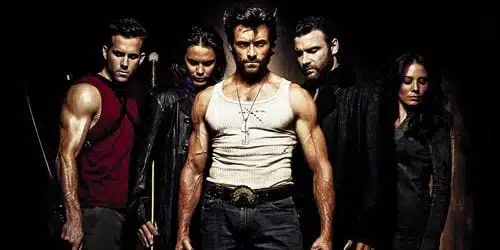
As Wolverine, Hugh Jackman is totally vascular. A seeming mountain of press has been given to the training regimen Jackman undertook in preparation for X-Men Origins: Wolverine. Entertainment Weekly dedicated the opening paragraph of its cover article on the film to the bulk-up. Muscle Measure extolled his dedication and detailed his program, and fans have been quibbling over whether he could have achieved such mass without the help of steroids.
However he achieved it, Jackman’s body is the movie’s front and center focus, as the Wolverine Anger Pose — arms extended with claws out, shoulders hunched, and head thrown back in a bestial howl — is repeated ad nauseam. In these tableaux, muscles strain against and ropy veins seem just about ready to pop out his skin. It’s creepy and a little bit gross, as if People‘s reigning “Sexist Man Alive” wanted to tarnish that title just a bit.
Scary as that body may be, it’s also perfectly appropriate as a visual extension of the weaponization of Wolverine. Wolverine’s muscles and adamantium claws, provided courtesy of Col. William Stryker’s (Danny Huston) “Weapon X” program, project the militarized masculinity that is at the heart of the film. As its title suggests, it fills in origins blanks, opening on a dark and stormy night (it’s that clichéd) in the wilds of Canada in the mid-19th century. We find the young James/Logan/Wolverine amongst his family, just as his mutant powers surface for the first time, with tragic consequences. Here, the film nicely nods to the comic industry by following rather closely, with some creative license, the trajectory established by Marvel’s 2001-2002 six-issue Origin. The yet-to-be-Wolverine (played as a boy by Troye Sivan) and his brother Victor (Michael-James Olsen as a child, Liev Schreiber as an adult) flee the scene and later join the U.S. military.
During the title sequence that ensues, we are shown clips of the brothers’ involvement in various U.S. conflicts, from the Civil War to Viet Nam. The World War II scene in particular recalls familiar imagery of the storming of Normandy beach from Saving Private Ryan and Band of Brothers, underlining connections between brotherhood, manhood, and military aggression.
It’s a bit of a disappointment that X-Men Origins: Wolverine is such a thoroughly brotherly affair. The various X-Men comics series have been groundbreaking in the industry for routinely incorporating women into their roster of superheroes, and the films have followed suit. But here, there are very few mutant sisters, and precious little for them to do other than get saved by the big, manly, brotherly boys.
Thus Wolverine and Victor, who will later be known by the moniker Sabretooth, find an outlet for their more brutish tendencies in the military. This brand of “brotherhood” is also repeated in the “special operations” unit into which they are recruited. Led by Col. Stryker, the unit is made up of mutants, like John Wraith (Will.i.Am), David North/Agent Zero (Daniel Henney) and Wade Wilson/Deadpool (Ryan Reynolds). But rather than simplistically assert the courage and patriotism of this brotherhood, the film demonstrates how is based upon the violent exploitation of others. Victor, it is suggested, takes willing part in the rape and murder of Vietnamese civilians à la My Lai, and the expedition of Stryker’s task force to Africa recalls colonialist extractions of natural resources, supported by Western militaries’ decimation of local populations.
The film also complicates the moral binary established in the X-Men film franchise. In that trilogy, clear lines are set up between the “bad” U.S. military and the “good” mutant resistance. Whether one sympathizes with the pole of minority activism represented by Charles Xavier’s (Patrick Stewart) assimilationism or Magneto’s (Ian McKellan) separatism, both clearly have the moral high ground.
In Wolverine, however, such distinctions get blurred. We know that Sabretooth will be one of Magneto’s primary henchmen in the “Brotherhood of Mutants,” and his embrace of violence for its own sake challenges our presumptions of the future righteousness of Magneto’s mutant army. Whether revolutionary resistance fighters or state military, both groups are shown to operate through violence and self-interest. Wolverine appears to be a potential solution. Disgusted with the motives and methods of Col. Stryker and his unit, he walks away from his mutant brothers. He finds solace in the isolation of the Canadian Rockies and in the love of Kayla Silverfox (Lynn Collins), who repeatedly reassures him that he “is not an animal.”
The trouble is that Stryker and the unit aren’t done with him. Eventually Wolverine realizes that in order to save himself and those he loves, he has to embrace that animal side. Rather than waiting for Stryker to come back for him, Wolverine decides to hunt down his former commander.
In this, Wolverine’s motives are not so different from Stryker’s, who asserts that, in relation to the mutant threat, “preemptive action is the only action here.” He adds, “We have to take the fight to the enemy before the enemy brings the fight to us.” It’s a sentiment all too familiar in light of U.S. deployments of the recent past — and because the villainous Col. Stryker makes the statement, we know it’s bad. Yet, as Wolverine follows a similar imperative, the movie suggests the difficulty of resisting that logic of self-preservation at all costs, despite the disastrous consequences of preemptive aggression — for Wolverine personally and the U.S. collectively.
